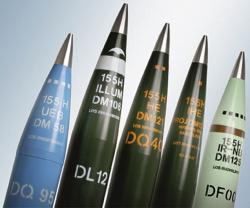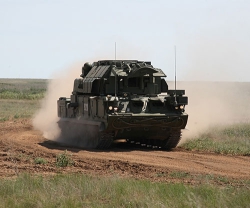Rheinmetall Tests 50kw High-Energy Laser Weapon
19.12.2012 Europe
Rheinmetall has successfully tested its new 50kW high-energy weapon technology demonstrator. Conducted at the end of November, the test encompassed the entire operational sequence from target detection and tracking to target engagement.
The test was conducted at Rheinmetall’s Ochsenboden Proving Groud (EZO) in Switzerland, in snowy conditions and blinding sunlight, and was initially supposed to show the increase in efficiency of the 50kW HEL weapon compared with the 10kW version demonstrated last year.
A five-fold increase in laser power was thus available for the individual scenarios, which included Air Defense, Counter Rocket, Artillery, Mortar/C-RAM, and Asymmetric Warfare operations. Furthermore, the tests were intended to prove that separately located HEL weapon stations using Rheinmetall’s existing Beam Superimposing Technology (BST) are able to irradiate a single target in a superimposed, cumulative manner.
This modular technology approach makes it possible to maintain the very good beam quality of the individual laser modules, increasing overall performance several times over. Thus, from the technical stand-point, nothing stands in the way of a future HEL weapon system with a 100kW output.
The 50kW HEL weapon technology demonstrator consisted of two functional models: a 30kW weapon station integrated into an Oerlikon Revolver Gun air defense turret for static and dynamic tests, coupled with an Oerlikon Skyguard fire control unit; and a 20kW weapon station integrated into a Revolver Gun turret of the first-generation, patched in for static tests. There were also additional modules for supplying power.
Witnessed by leading experts, the demonstration delivered compelling evidence for the 50kW HEL weapon technology demonstrator’s high stability: a massive, 15mm-thick steel girder was cut through at a distance of 1,000 meters. The successful shooting down of several nose-diving target drones at a range of two kilometers formed the second major highlight.
Though they were flying at over 50 meters a second, the Skyguard radar had no trouble detecting the incoming unmanned aerial vehicles at a distance of three kilometers. Then the 30kW weapon station used the Skyguard data to carry out rough tracking mechanically. The optical tracking system in the Beam Forming Units (BFU’s) in the individual leaser weapon modules performed fine tracking of the UAVs. After reaching the programmed fire sector the
laser weapon modules engaged the UAV’s immediately and destroyed the incoming UAVs within a few seconds.
The third highlight: detection, pursuit and successful engagement of an extremely small ballistic target. A steel ball measuring 82 mm in diameter and travelling at approximately 50 m/sec, the target replicated a mortar round. The Skyguard fire control unit immediately detected the target, followed by mechanical tracking with the 30kW laser weapon station. At this point, the BFU of the laser weapon module took over, optically tracking the target, which was then engaged and destroyed in flight, leaving no doubt as to the tactical viability of using laser weapons in future C-RAM scenarios. Moreover, the test makes clear that the time necessary for engaging mortar rounds at long ranges can be substantially reduced. Today, the required engagement time is already low enough to be in the region needed for C-RAM applications, even when adverse weather conditions make targets difficult to detect.
The test was conducted at Rheinmetall’s Ochsenboden Proving Groud (EZO) in Switzerland, in snowy conditions and blinding sunlight, and was initially supposed to show the increase in efficiency of the 50kW HEL weapon compared with the 10kW version demonstrated last year.
A five-fold increase in laser power was thus available for the individual scenarios, which included Air Defense, Counter Rocket, Artillery, Mortar/C-RAM, and Asymmetric Warfare operations. Furthermore, the tests were intended to prove that separately located HEL weapon stations using Rheinmetall’s existing Beam Superimposing Technology (BST) are able to irradiate a single target in a superimposed, cumulative manner.
This modular technology approach makes it possible to maintain the very good beam quality of the individual laser modules, increasing overall performance several times over. Thus, from the technical stand-point, nothing stands in the way of a future HEL weapon system with a 100kW output.
The 50kW HEL weapon technology demonstrator consisted of two functional models: a 30kW weapon station integrated into an Oerlikon Revolver Gun air defense turret for static and dynamic tests, coupled with an Oerlikon Skyguard fire control unit; and a 20kW weapon station integrated into a Revolver Gun turret of the first-generation, patched in for static tests. There were also additional modules for supplying power.
Witnessed by leading experts, the demonstration delivered compelling evidence for the 50kW HEL weapon technology demonstrator’s high stability: a massive, 15mm-thick steel girder was cut through at a distance of 1,000 meters. The successful shooting down of several nose-diving target drones at a range of two kilometers formed the second major highlight.
Though they were flying at over 50 meters a second, the Skyguard radar had no trouble detecting the incoming unmanned aerial vehicles at a distance of three kilometers. Then the 30kW weapon station used the Skyguard data to carry out rough tracking mechanically. The optical tracking system in the Beam Forming Units (BFU’s) in the individual leaser weapon modules performed fine tracking of the UAVs. After reaching the programmed fire sector the
laser weapon modules engaged the UAV’s immediately and destroyed the incoming UAVs within a few seconds.
The third highlight: detection, pursuit and successful engagement of an extremely small ballistic target. A steel ball measuring 82 mm in diameter and travelling at approximately 50 m/sec, the target replicated a mortar round. The Skyguard fire control unit immediately detected the target, followed by mechanical tracking with the 30kW laser weapon station. At this point, the BFU of the laser weapon module took over, optically tracking the target, which was then engaged and destroyed in flight, leaving no doubt as to the tactical viability of using laser weapons in future C-RAM scenarios. Moreover, the test makes clear that the time necessary for engaging mortar rounds at long ranges can be substantially reduced. Today, the required engagement time is already low enough to be in the region needed for C-RAM applications, even when adverse weather conditions make targets difficult to detect.
Latest news
Latest events
IDEF 2025 Turkey - International Defence Industry Fair
22 - 27 Jul 2025Istanbul Expo Center - TurkeyDSEI 2025
09 - 12 Sep 2025Excel, London - United KingdomIntersec Saudi Arabia
29 Sep - 01 Oct 2025Riyadh International Exhibition & Convention Centre - Saudi ArabiaDubai International Air Chiefs’ Conference (DIACC 2025)
16 Nov 2025Atlantis, The Palm Dubai - United Arab Emirates






















